Test drive Mercedes Benz G-class W463 since 2012 SUV
Black box
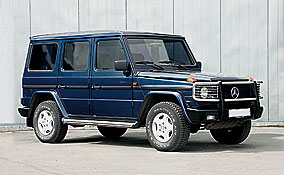 For excellent cross -country ability, angular design and an uncouth riding character, he was nicknamed the German UAZ. And thanks to the high image of the brand and an exorbitantly high price, they erected to the cult. Therefore, even for a wealthy person, the dream of Gelendevagen becomes a reality only when the car is three years old.
For excellent cross -country ability, angular design and an uncouth riding character, he was nicknamed the German UAZ. And thanks to the high image of the brand and an exorbitantly high price, they erected to the cult. Therefore, even for a wealthy person, the dream of Gelendevagen becomes a reality only when the car is three years old. 23 years on the conveyor
The Mercedes-Benz G-Class, or Gelendevagen (in the literal transfer-mud car), made his debut in 1979, is released to this day and, most likely, will celebrate a quarter-century anniversary on the conveyor. He was designed as an army all-around, but unexpectedly, private buyers showed interest in the car, and the G-class appeared in the dealers salons.
At first, the G-Vagen was quite ascetic: low-power low-speed engines, connected front-wheel drive, Spartan interior. These are cars of the G460 and G461 series. The latter - a utilitarian Gelendauger, intended for military, builders, various services, is also produced in our time. It is extremely rare on the market and this is not the best option for buying. Yes, it costs inexpensively, but, firstly, this is not the Gelendauger that you want to see, and secondly, such machines are operated very intensively, and by the time of sale, all juices from them are usually already squeezed out.
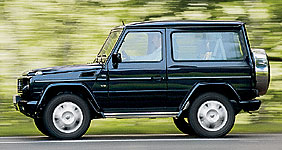 We are interested in the more civilian series G463, which appeared in 1989 in response to the increased demands of private buyers. This is the familiar Gelendauger with a constant all -wheel drive and a more convenient, rich interior. Outwardly, the G463 is characterized by a more round plastic frame of the front headlights. Moreover, we will consider cars since 1996, when the 463rd series acquired a modern 3-liter turbodiesel and got rid of all dead gasoline engines, preserving only a powerful in-line six of 3.2 liters under the hood.
We are interested in the more civilian series G463, which appeared in 1989 in response to the increased demands of private buyers. This is the familiar Gelendauger with a constant all -wheel drive and a more convenient, rich interior. Outwardly, the G463 is characterized by a more round plastic frame of the front headlights. Moreover, we will consider cars since 1996, when the 463rd series acquired a modern 3-liter turbodiesel and got rid of all dead gasoline engines, preserving only a powerful in-line six of 3.2 liters under the hood. If at the sight of Gelendevagen you are not yet set to accept it as it is, then before buying this car you need to carefully look, sit down and be sure to travel on it. To either refuse to buy, or get used to it. Believe me, if you evaluate the G-Vagen, without being under hypnosis of the three-beam star, and at the same time correlate estimates with the price of the machine, then at first it makes a shocking impression
Mc Laren-Mercedes G-class
When the next million managed to earn another million, and in the underground parking of your elite house, ten more of the same black Gelendevagenes rest - life becomes unbearable. There is only one way out - turn to the masters of tuning: Brabus, Karlsson, etc. They pump up the motor, imprison the chassis under the quick riding, will be adjusted to the appearance and turn the salon into a first -class cabin. They may even book Gelendevagen if the owner knows that that million was intended for someone else.
Surely you saw such cars - on huge low -profile bast shoes, with a front spoiler, hoping along the asphalt, and small, as if from a bandage, heads of headlights, the number of which is doubled.
And in the secondary market, you can buy such a car - at least represses. The question is, is it necessary. Suppose interior tuning, as they say, does not affect speed. But with a front spoiler from a brabus, clamped by a sports suspension and low-profile rubber G-Vagen, moving off the asphalt, becomes absolutely helpless. If you need a quick highway and a must-be, it is better to purchase an M-class from AMG or BRABUS. And in Gelendevagen, sports tuning is as functional as an enlarged clearance and mud rubber for Mc-Laren-Mergedes David Kultard.
German UAZ
Suppose, looking at this car, like Malevich’s canvas, if you wish, you can convince yourself that a black square is a great art. By the way, only in Russia almost all the gelendevagenes are black - apparently, their owners have already prepared an epitaph for themselves ... In fact, there are burgundy, silver, and even white.
When you see the outer door hinges and gaps into the finger with a thickness through which the shiny metal metal of the castles, the eyes become square, become square. The Germans explain this design by the fact that when the body is overwhelmed on bumps, large gaps do not allow the doors to touch the openings. Perhaps you can agree. It is more difficult to come to terms with the fact that the doors are closed with a metal clang and they must be clapped with male force. It is not surprising that after a while the locks are spanning and after a single adjustment you have to change their brackets.
Now we climb into the salon. It is climbing: the doors are narrow, and the thresholds are high. We sit down on a high stool, put our hands on a fixed lamb (it received the adjustment only in 1999), and the flat door supports the shoulder. Not otherwise, German specialists in ergonomics drew inspiration in Ulyanovsk. By the way, leaning harder on a folding armrest, you will probably break it (at first almost everyone breaks). Then pay $ 80 and will not break.
But the equally highly located even rear sofa will most likely appeal to passengers. It is possible that it will even be equipped with heating.
Some find the interior of Gelendevagen very comfortable and even luxurious. We will not argue, you have already familiarized yourself with the ergonomics of the German jeep. And as for the skin and wood - if you put them on the tank tower from the inside, then it is unlikely to become Rolls -Royce from this.
By the way, the skin is not at all required even on fresh cars. As well as air conditioning, stereo system, electric drive, heating and swinging seats, heating of the windshield, etc. All these are options. In 1997, for example, only ABS, two airbags, cruise control, a leather steering wheel and an electric package with a central lock were standard. And the salon in the base is fabric. Moreover, if you bring an almost standard Gelendauger from Europe (there are enough of them there), it will be a little cheaper than a silver. The lion's share of the price (and values!) Of this car is laid in iron, and not in the gaming. Only 8-cylinder G500, which appeared in 1998, are guaranteed richly equipped.
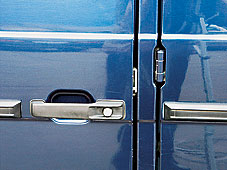 From castles to buttocks
From castles to buttocks In addition to door locks, there are few other body problems. The hatch in the roof begins to seize over time. If you contact the technical center at once, you will bypass the replacement of the slide. You will wait when the hatch is completely jammed, pay twice as much. The appearance of light cosmetic corrosion on cars over 8 years old is possible around the door handles and at the seams between the side of the body, the posterior wall and the roof. And the flat body panels do not like tiners: no matter how hard you are - traces of the repair are still noticeable.
If a factory rearrangement is installed, then an ethletric connector can be bent from our salt. But this is nonsense - it is treated with wiring.
What is the price
Replacing the brackets of door locks, 5 pcs. $ 170
Replacing Luke Salad $ 200
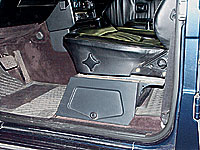
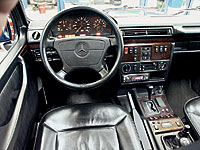
Upon closer examination, it turns out that many details of the cabin are made with army sophistication. What are at least iron instrumental boxes on which the front seats are fixed
Tsarist carriage or still Arba?
In behavior on the G -Vagen road - a natural truck. The noise of the engine into the salon erupts more than the expected, the wind whistles brick body with a whistle, and the pebbles echoed on the wheel arches echoing. Apparently, it is impossible to radically improve the sound insulation of the army jeep.
The concepts of the smoothness and reliability of management are applicable to the G-vagen only in the sense that he still has springs in the suspension, and he still reacts to turn the steering wheel and press the brake pedal. There is nothing to be done - a strong and hardy chassis with addicted beams -bridges is ideal for off -road, but not for asphalt. The conflict between the ability of the engine and the chassis of the chassis in an excessively powerful G500 is especially noticeable. Taking this angry bull is not easy.
Even if you find yourself in a good cowboy, driving at speeds under 180 for Gelendevagen will still be released sideways. First of all, cardan shafts suffer from it - the one between the gearbox and the handout, and the front. Then the bearings of the handouts, the rear pennies and, possibly, the main pairs will buzz. To the maximum, a quick ride can result in thousands of four dollars.
And what are you, in fact, amazed? The transmission of a professional all -terrain vehicle is designed for high moments, but not for quick rotation. Services taught by other people's experience strongly do not recommend traveling on Gelendevagen faster than 140 km/h. In this regard, cars of German origin are at risk, where the speed is not limited on autobahns, and Russian, where a powerful engine has always been a guide to action. It is best to look for a G-Vagen in a rich mountain Switza-the cars there are well-groomed, and for the speed above 130, the local police are fine so that it does not seem enough.
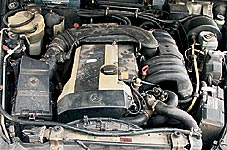 Those who prefer gasoline
Those who prefer gasoline Any of the G-Vagen gasoline engines after 100-140 thousand km begins to lose power, adds to fuel consumption, and then it is taken to shoot at an air filter or in the exhaust pipe. So, the air flow meter has developed its term. The main thing is to identify its malfunction, since the specified characteristics do not immediately go away. But if the cause is established, then it changes is not difficult.
Now about branded diseases. On M104, after about 50-60 thousand km, interruptions in work caused by candle caps that combine the role of high-voltage wires are possible. Another branded disease M104 - the leakage of the gaskets of the head of the block and the front cover - was almost out of 1996. In extreme cases, pay $ 430.
How many times during this time you can change candles, one god knows. They serve on our gasoline from 5 to 20 thousand km. But they are inexpensive. But the replacement of candles on V-shaped motors should be taken with all seriousness. They use platinum candles, which on high -quality gasoline can last 60,000 km. But in our conditions, they usually have to be changed twice as often. Only now there are two of them on the cylinder and they cost almost four times more expensive. And you can’t pull with a replacement. Passes in the ignition lead to the fact that unbroken gasoline rinses oil from the walls of the cylinders, and the block - aluminum. Therefore, the bullying from the rings appear instantly. I think there is no need to talk about the consequences.
All Mercedes engines begin to eagerly eat oil at high speeds. But on the M112-M113, even with moderate driving, oil consumption can reach 1 l/1000 km. Do not panic - this is a normal phenomenon. Now, if the oil disappears even faster, it is time to throw the candles.
Every 40-50 thousand km on the M112-M113, it is necessary to check the condition of the pulley of the drive of auxiliary units. Sooner or later, his rubber damper will begin to be divided, and the pulley must be changed immediately.
In the risk group on the M112 -M113, injections of injection falls - they can be serviceable after 100,000 km, and can lock after 40,000 km. It all depends on how good gasoline is at your favorite refueling. Symptoms: interruptions in work, power loss and difficult start.
What is the price
Replacing candles M104 $ 75
Replacing candles with candles (M104) $ 140
Air flow meter $ 350-380
Replacing gaskets (M104) $ 430
Replacing candles (M112/ M113) $ 215/280
Drill replacement (M112-M113) $ 130
Checking the injections of injection $ 170
Nozzle (M112-M113, 1 pc.) $ 107
Her Majesty is blocking
The phenomenal patency of the G-Vagen is due to many factors: a large gear ratio of lowering gear in the handout, long-term dependent suspension, short overhangs, as well as a successful layout of the units under the bottom.
But still, the most important thing is the presence of a forced blocking of all differentials: the intends and both inter -celes - the rear and front. This means that with complete mobilization of locks in any situation, all four wheels will row synchronously. In addition to Gelendevagen from the currently produced jeeps, only a few modifications of Lend-Croizer-100GX have forced front blocking.
Clocks must be able to use. On an ordinary road, even slippery, they should not be turned on. Moreover, this is even dangerous, since the machine becomes difficult to control. Differentials are blocked only in cases where the machine loses the ability to move with unlocked ones. That is - on off -road.
The central lock should be used even on a flat but modest primer. And before leaving to the hard surface, it can not be turned off. But the rear and front locks should be used for a short time and only in particularly difficult conditions. For example, in deep mud or during the overcoming of diagonal irregularities. At the same time, it is advisable to keep the steering wheel straight, because in corners with blocked inter -coil differentials (especially the front), the transmission experiences heavy loads.
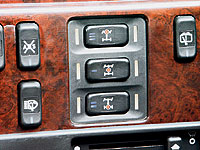
The procedure for turning on the locks is indicated by Roman numbers on the buttons: central, back and then the front. It is impossible to break the sequence - in the electric circuit, protection from the fool is provided.
And the motors are cars
In the past six years, four engines - three gasoline and one turbodiesel have installed civil gelendevagens. Which one to choose is the question of your personal preferences and prices of the car. There are no frankly unsuccessful engines.
Although, usually for professional jeeps, low -speed engine engines adapted to off -road are specially developed, the same engines are used on the G463 series as on passenger Mercedes. All of them have not requiring attention of the chain timing and quite durable. At the same time, traditionally demanding on the quality and timely replacement of oil and coolant.
Until 1997, a row gasoline six of 3199 SMZ M104 model was installed on the G320. Its capacity in 211 forces is enough for heavy Gelendevagen, and fuel consumption is 17-22 l/100 km.
The radiator on Gelendevagen is located higher than on a passenger car, and during conventional operation it is clogged with dirt not so actively. However, it can be fed to the dump in tall grass. Therefore, after such trips, cleaning the radiator is required. After all, clogged, it can cause overheating of the motor, which the six M104 is especially afraid of. Her head head is long, and when overheating it is very strong.
In addition, in the heat, the engine can overheat if additional fans located immediately behind the radiator is not operated. On a hot motor, they should begin to rotate after turning on the air conditioner. However, their electric motors are won from salt through three to four seasons. If the condo is turned on, and the fans are silent, change their motorokers immediately ($ 300 for each).
Five years ago, it was replaced by the V6 M112 V6 engine - the same volume, but with three valves on a cylinder with a capacity of 215 forces. High-speed and dynamic qualities have practically not changed, but v6 is quieter, environmentally cleaner and one or two liters more economically more economical than its predecessor.
A year later, a V-shaped eight of the M113 model with a volume of 4966 cm appeared on the G500 model. Structurally, it is identical to the V6 engine. Of course, 296 l. With. They give Gelendevagen a completely plague dynamics for him and increase fuel consumption by 18-25 l/100 km.
If you carefully, with a pencil in your hand, spent the above table of costs for repairing motors, it turns out that the V6 is more capricious and roads in operation than a in -line six. Therefore, when buying the G320 of 1996-1997, it may make sense to dwell on the good old M104. The car he has equipped and will cost cheaper.
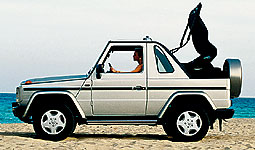
The three-door G-vagar in Russia is a rarity, and the convertible on its base is completely unique
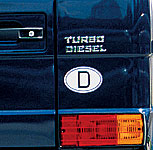 Diesel cares.
Diesel cares. Compared to the old Mercedes diesels, which were unbearable, the OM606 motor is considered less reliable. Largely due to the fact that, to place it in the head of the 24 valves, it had to be made thin-walled. As a result, from low -quality fuel or driving with a gas pedal in the floor, the block head is not withstanding, and sometimes the head itself cracks. However, recently, there have been fewer complaints about fuel, and if the driver realizes that under the hood is still a diesel engine, then you can protect yourself from large expenses.
The turbine is also waiting for the queue to facilitate your wallet. Even if you handle it correctly (do not jam the engine right after stopping, change the oil and air filter in time), the turbine can be unsubscribed of a maximum of 200,000 km of run.
But unlike most diesel engines, fuel equipment on this engine is quite reliable. The fuel pump is poorly available to poor diesel fuel and repair, and the sprayers of nozzles on our fuel withstand 100,000 - 140,000 km - a very good indicator. Other possible malfunctions such as failure of the air temperature sensor are trifles.
What is the price
Replacing block head of the block $ 500
Replacing the head $ 2500
Turbine $ 1800
Repair of TNVD $ 500-1000
Replacement of nozzles of nozzles with adjustment (6 pcs.) $ 380
Alternative to gasoline
The in-line six of the G300-turbodiesel model is indicated by OM606 and also has a passenger origin. The motor is quite high -speed. Therefore, from three liters of volume it was possible to remove 177 liters. With. In the speed and dynamics, the G300 is almost not inferior to the G320, but it drinks from a 96-liter tank only 13-15 liters per hundred. And not 95th gasoline, but diesel fuel.
Thus, even at first glance, the purchase of diesel Gelendevagen is quite a reason. And if you still remember that he is contraindicated in fast riding and poor -quality fuel, if you strictly fulfill the rules for the operation of diesel engines and take care of the turbine, diesel on Gelendevagen will be justified even taking into account the replacement of the turbine.
The oil in bridges and in the handout changes after 90,000 km (in an off -road conditions twice as often). But if I had to climb into the swamp or in the back on the very most, then immediately after that it is necessary to control the condition of the oil in the units. Emulsion appeared? Urgently change.

The pre-heater of the engine and the webasto-top-top cabin-the factory option. If his electronic unit flew, you have to change the boiler assembly ($ 540)
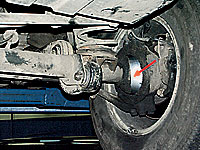 Weakness
Weakness A weak place in the Golendevagen chassis? It happens that the rear springs burst. But recently, damage has become much less - apparently, the disease has been cured.
Sometimes the front bridge is also bend when at a speed of 60-80 km/h jump off-road or border stones. True, in this case, a weak spot should be sought in the skull box of the driver - on the right or to the left of the only gyrus.
If the steering gearbox flowed, most often it is possible to limit ourselves to replacing the lower bipod oil seal (this is a penny). True, after a strong blow, it may be necessary to replace the gearbox assembly. Finally - exhaust. It rotates evenly along the entire length and quite quickly - through Moscow salt after four to five winter. And costs about $ 2000. But nothing, a weak place should be in the Golendevagen chassis.
What is the price
Cardan shaft (intermediate, front, rear) each $ 800
Replacing lubrication in the front bridge $ 400
Breeding the front axle $ 2000-4000
Front bridge assembly $ 5000
Repair of front brake calipers $ 160
Steering reducer repair $ 100
Steering gearbox assembly $ 3300
On the needle
Many people believe that Gelendevagen is a tank and that, they say, there is nothing to serve it. In fact, like most jeeps with a dependent suspension, his transmission sits tightly on the needle. Strictly every 10,000 km should be syringed, stuffing with lubricants, crosses and crankage slots. If this is not done, after 50-60 thousand will begin such a breakdown since the crosses of this car are non-removable, the cardan will have to be changed assembly. And if the knocking cardans have time to break the bearings of the handouts or the main pairs of bridges, then the consequences of saving on maintenance will be comparable to the consequences of fast driving.
The same applies to the need to replace the lubricant in rotary fists (arrow in the picture on the left) and the wheel bearings of the front bridge every 60,000 km, and with intensive operation on roadway - half as often. The work is very time -consuming and is not cheap, taking into account the cost of oil seals, paper pads, etc., which are changing. But if this requirement is ignored, the drive seals will fly over time, the consistent lubrication of the swivel fists is mixed with the liquid oil of the main pair and came to the bulkhead of the bridge.
However, if you are a neat driver, you know how to curb your temperament and punctually perform all of the above work, then, as can be seen from the table, there is nothing to do in the chassis of up to 80,000-100,000 km. It follows from it that, in contrast to the carbon -mined Mercedes, which require tangible injections on the chassis on every second one (see Limuin, No. 8, 2001), the owner of Gelendevagen will be spent rarely and gradually. Moreover, replacing some detail once, he most likely will never remember her anymore.
Unsplanned expenses include the need for periodic repair of front brake calipers, which varnish or flow from salt more often than on other Mercedes models. Typically, calipers can be reanimated using a repair kit.
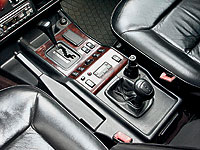 Only a machine gun
Only a machine gun When buying a Gelendevagen, remember that the checkpoint in it will be automatic. Because after 1996, a manual gearbox was not installed on the machines of the 463rd series in principle. If the car you attracted is equipped with a row gasoline six, then you will get a 4-speed machine. It is quite reliable and nurses 200-250 thousand km. It usually breaks from improper operation.
All other motors were equipped with a new 5-speed box with electronic control. It switches more smoothly and logically, with less delay. Initially, this box was considered underdeveloped. But, as experience shows, in any machine, oil must be changed. And the more often, the better. Therefore, at least after 30,000 km in a 4-speed automatic transmission and after 60,000 km in the 5-speed procedure it is necessary to do this procedure. Moreover, in a more perfect aggregate, proprietary Mercedes synthetics is used not compatible with the usual destron-II. The cost of repairing the mechanical part of both automatic transmission is the same. But it happens that in a 5-speed sphery, electronic security, as a result of which the machine rises into emergency mode and does not switch above the 2nd gear. Usually it is possible to get by replacing one of the electronic boards.
We will not repeat the rules for the operation of automatic machines for the hundredth time, but recall only one, applied to off -road specifics. If the wheels are hard to crank up (deep snow, dirt, steep rise) - turn on the lowering gear. Otherwise, the transmission experiences increased loads.
What is the price
Repair of the mechanical part $ 1000-1500
Electronic fee (5-Test.) $ 150
The nicks of the handouts begin to sweat after 100,000 km, and usually flow closer to the second hundred. Then change them. The sear of the tails of bridges is double and very reliable. So that the oil seals do not flow ahead of time, you should clean the ventilation sapons of the transmission units on each.
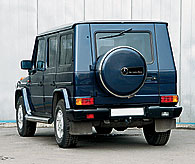 We buy an image
We buy an image If you are tuned to buy a Gelendevagen brought from Europe, then the situation with prices is as follows:
1996 $ 29 000-35 000
1997 $ 33,000-42,000
1998 $ 39,000-52,000
1999 $ 45,000-59,000
At the same time, the G320 and G300-turbodiesel are the same, and the G500 is estimated at $ 4000-6000 more expensive. Rare three-doors for $ 3000-5000 are cheaper than similar five-doors.
On the one hand, looking at these numbers, you realize that buying a used Gelendevagen is much more profitable than a new one. He is not subject to moral aging, and physically, for three or four years, as it turns out, he almost does not pass. But the price by this time becomes more or less real.
But on the other hand, if you need a professional roadman, then for the price of a g-vagen-three-year-old you can buy a patrol or a land-kroizer-100gx-cars of the same class, only much more modern, convenient and, I assure you, no less resilient . If you want something more sophisticated and advanced-please, Pajero-III or Grand Counts. Moreover, all of them will be not just more fresh, but new, with a guarantee. If without a guarantee, from a gray dealer, then at the price of a three-year-old G500, even a new Lend-Croizer-100VX buy.
Yes, the Gelendevagen is outdated. Hopelessly outdated. Today, objectively, he is no longer worth his money - neither new nor used. Accordingly, in order to force buyers to give such money for him, the Germans had one - to create a high image to the G -class. They coped with their task. And your task is to determine for yourself what you want to get - a car or image.
However, among the owners of Gelendevagen, units are unhappy with a car. Much more fans.
Alexander Konov, photo Alexander Sadovnikov
Source: Magazine "Limousine" [07-08/02]

